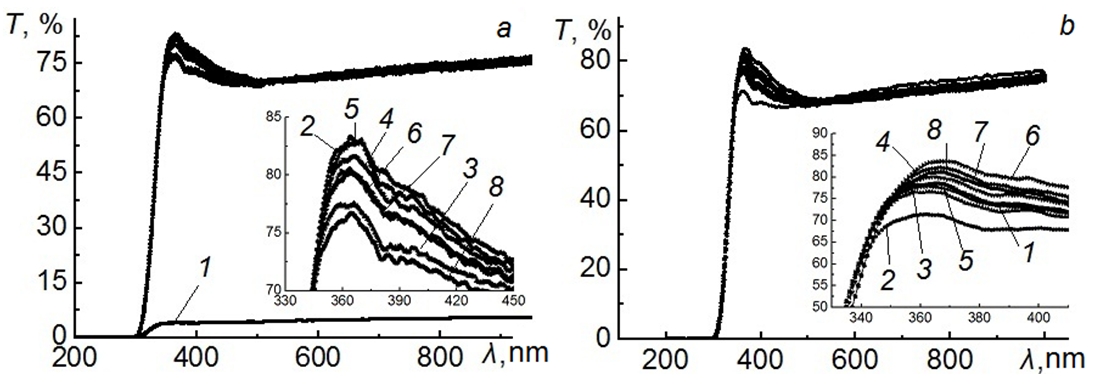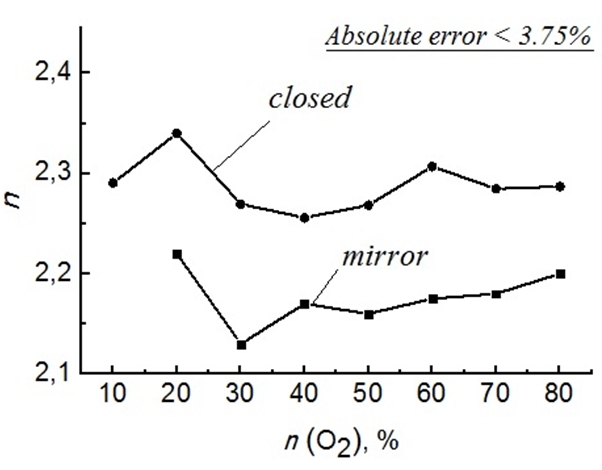ОПТИМАЛЬНЫЕ РЕЖИМЫ РАБОТЫ ДУАЛЬНЫХ МАГНЕТРОНОВ ДЛЯ ОСАЖДЕНИЯ ТОНКИХ ПЛЕНОК TiO2
Сиделёв Д.В.1, Юрьев Ю.Н.2
1Магистрант; 2заведующий лабораторией, Национальный исследовательский Томский политехнический университет
ОПТИМАЛЬНЫЕ РЕЖИМЫ РАБОТЫ ДУАЛЬНЫХ МАГНЕТРОНОВ ДЛЯ ОСАЖДЕНИЯ ТОНКИХ ПЛЕНОК TiO2
Аннотация
Исследования оптических свойств тонких пленок TiO2, полученных при помощи дуальной магнетронной распылительной системы (МРС), свидетельствуют о зависимости характеристик пленок от их структурных особенностей, которые определяются режимом работы МРС и конфигурацией магнитного поля магнетрона.
Ключевые слова: магнетронное распыление, дуальный магнетрон, тонкие пленки.
Sidelev D.V.1, Yurjev Y.N.2
1Master student; 2head of laboratory, National Research Tomsk Polytechnic University
OPTIMAL OPERATION MODES OF DUAL MAGNETRONS FOR DEPOSITION TiO2 THIN FILMS
Abstract
The investigation of optical properties of TiO2 thin films, obtained by a dual magnetron sputtering system (MSS), shows that optical characteristics of films depend on their structure and determine by operation mode and configuration of the magnetic field of the magnetron.
Keywords: magnetron sputtering, dual magnetron, thin films.
Currently, coatings based on titanium dioxide (TiO2) thin films widely used in medicine and optics owing to high optical and photocatalytic properties [1]. Among of physical and chemical methods of producing TiO2 films [2, 3], should be allocated magnetron deposition of having the greatest technological application for the deposition of oxide films. Dual MSS has a lot of advantages concerning other modifications of magnetrons, such as: a high deposition rate, a discharge stability, a no problem "disappearing" anode.
The present work is aimed to determine optimal operating modes of magnetron for deposition TiO2 films with desired optical characteristics at various configurations of the magnetic field of magnetron.
Experiment
Deposition of TiO2 thin films produced by the vacuum installation "Yashma" with the dual MSS in Ar and O2 gas mixture. The total constant pressure is 0.12 Pa. Substrates were a glass GOST 9284-75 and monocrystalline Si, whose surfaces are subjected to ion treatment for cleaning. The film thickness was 50 nm and controlled by a quartz gauge "Micron-5". Determination of transmission and refraction spectra produced by the spectrophotometer SF-2000 and ellipsometer "Ellipse 1891", respectively.
Results and discussion
Type of the magnetic field configuration of the dual magnetron (mirror or closed [4]) strongly influences on his operation parameters. According to Fig.1, increasing of O2 in the mixture is gradually changed the operation mode, due to drop of deposition rate (V) and average discharge power (W). In both cases, magnetron operates in metallic mode under low O2 content in mixture. Ti films are deposited. In the "a" case, a "poisoning" target is started at 20% O2 and characterized by the drop of V and subsequent reduction of W. The magnetron works in a transition mode. Further, the strong decrease of the deposition rate and discharge power under a 40% O2 in the mixture shows a high extent of target oxidation. MSS sputters oxide films from target (oxide mode). In the case of a closed field, boundaries of MSS modes are other: 10% O2 in the gas mixture – shift metal in the transition regime, 50% O2 - the boundary of the transition mode and regime of the sputtering oxide.
Fig.1 – The dependence of deposition rate and average discharge power on content O2 in the gas mixture under closed and mirror configuration of magnetic field
Such changes in behavior of MSS are due to the different directions of particle fluxes in the case of a mirror and a closed configuration of the magnetic field. In the second case, there is more intense bombardment by gas ions of the target and the substrate. On the one hand, it leads to the expansion of the transitional mode. On the other hand, there is a relative drop of the V due to the destruction of the islets of the film growth.
The transmission spectra of TiO2 films are shown in Fig. 2. The example №1, which was obtained at 10% O2 in the "a" case, is an opaque and metal film. The other samples are transparent (T ∽ 69 ... 84%). Hereby, it is confirmed the correctness of determination of operating modes.
TiO2 films are almost no absorption materials [3]. Therefore, the change of T is due to the light scattering, the intensity of which depends on the structural characteristics of films: number defects and type of the crystalline phase. Magnetron sputtering ensures deposition films with amorphous structure (for thicknesses <100 nm), which contain voids and pores. There is reduction the intensity of light scattering and increase transparency of films as compared with a dense film [5]. For denser films, crystallite size is increased and number of defects drops. Accordingly, transparency reduces. Thus, the transmission spectra can be a qualitatively evaluation of film defectiveness.
Fig.2 – Transmission spectra of TiO2 films (a – mirror field, b – closed field) under different content O2: 1-10%, 2-20%, 3-30%, 4-40%, 5-50%, 6-60%, 7-70%, 8-80%
The refractive spectra (n) at λ= 632.8 nm shows that the films are amorphous (Fig. 3). In the case of a closed field, TiO2 films have a higher n by reducing the defects number and packing films thro increasing ions flow to the substrate. It is comparable with the effect of bias potential.
Fig.3 – The dependence of n on content O2 in the mix at λ=632.8 nm
The maximum refractive indices are achieved at 20% O2 in the mix by right of possible high-rate deposition mode of transparent TiO2 films (transition regime).
The estimation of the films phase structure were obtained were based on measurements bandgap TiO2 films for the case of an indirect allowed transition (Table 1). It is built on the J. Tauc method [6]. Based on these Eg, the crystalline phase in the films is absent (for anatase – 3.2 eV, rutile – 3 eV). Moreover, the relationship Eg ∽ 1/n is defined. Similar results were obtained in [2].
Table 1 - The dependence of n on Eg for TiO2 thin films
| n(O2),% | 20 | 30 | 40 | 50 | 60 | 70 | 80 | |
| mirror field | n | 2.22 | 2.13 | 2.17 | 2.16 | 2.18 | 2.18 | 2.21 |
| Eg, eV | 3.41 | 3.52 | 3.48 | 3.49 | 3.47 | 3.46 | 3.45 | |
| closed field | n | 2.34 | 2.27 | 2.23 | 2.27 | 2.31 | 2.29 | 2.29 |
| Eg, eV | 3.33 | 3.4 | 3.43 | 3.39 | 3.34 | 3.36 | 3.35 | |
From a position of technology, using dual magnetron is more effective process of deposition of oxide films (TiO2) compared to other modifications magnetrons (Table 2). In conjunction with the high optical properties of samples should be said about the great potential of application dual magnetron in modern industry, such as the deposition of anti-reflection layers in the low-e coating.
Table 2 - The deposition rate of TiO2 films
| type of magnetron | V, nm/s |
| high-frequency magnetron | 5∙10-3 - 0.116 [7] |
| dual magnetron | 0.25 - 0.6 |
| direct current magnetron | 0.09 - 0.11 [14] |
| impulse magnetron | 2.2∙10-3 - 1.6∙10-2 [15] |
In addition, at the present our research group obtains stable operation mode of the dual magnetron with a "hot" target. It is allowed to deposit crystalline TiO2 films with higher rates than in this study, in recalculation on the discharge power.
Conclusion
The main results are as follows:
-growth of defects in the film leads to an increase T, for denser films the size of the crystallites decreases and transparency reduce, respectively;
-a better refraction is achieved by using a closed field of the magnetron by forming a dense structure;
-the dual MSS provides a stable deposition process TiO2 films with the highest rates due to the presence of a wide range of transitional regime.
Dual magnetron has good prospects in the industry as equipment for deposition oxide films and coatings based on them.
Список литературы
Horprathum M. Structural, Optical and Hydrophilic Properties of Nanocrystalline TiO2 Ultra-Thin Films Prepared by Pulsed DC Reactive Magnetron Sputtering // J. of Alloys and Compounds. - 2011. - Vol. 509. - P. 4520-4524.
Hasan M.M. Effects of Annealing Treatment on Optical Properties of Anatase TiO2 Thin Films // World Academy of Science, Engineering and Technology. - 2008. - №40. - P. 221-225.
Bendavid A. Deposition and Modification of Titanium Dioxide Thin Films by Filtered Arc Deposition // Thin Solid Films. - 2000. - №360. - P. 241-249.
Musil J., Baroch P. Discharge in Dual Magnetron Sputtering System // IEEE Transactions on Plasma Science. - 2005. - v.33, №2. - P. 338-339.
Mardare D. On the Structural Properties and Optical Transmittance of TiO2 R.F. Sputtered Thin Films // Applied Surface Science. - 2000. - №156. - p. 200-206.
Юрьев Ю.Н., Сиделёв Д.В., Кривобоков В.П. Оптические свойства тонких пленок диоксида титана // Изв. вузов. Физика. – 2013. - Т. 56, №4/2. - С. 350-353.
Stamate M. The Influence of Reactive Gaseous Flow Rate and Composition on the Optical Properties of TiO2 Thin Films Deposited by DC Magnetron // ACTA Physica Polonica A. - 2009. - Vol. 115, №3. - P. 755-757.
Stamate M. Optical and Surface Properties TiO2 Thin Films Deposited by DC Magnetron Sputtering Method // J. of Optoelectronics and Advanced Material. – 2005. – Vol.7, №2. - P. 771-774.
Stranak V. Physical Properties of Homogeneous TiO2 Films Prepared by High Power Impulse Magnetron Sputtering as a Function of Crystallographic Phase and Nanostructure // J. of Physics D: Applied Physics. - 2009. - Vol.42. - 105204.



